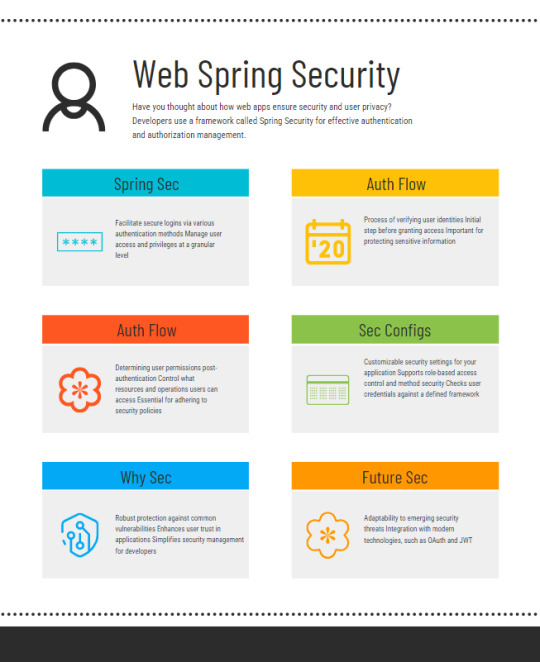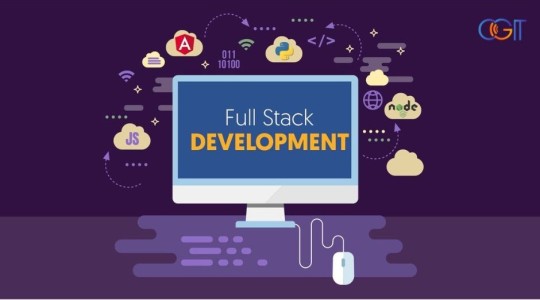#spring-oauth2
Explore tagged Tumblr posts
Text
Spring Security Using Facebook Authorization: A Comprehensive Guide
In today's digital landscape, integrating third-party login mechanisms into applications has become a standard practice. It enhances user experience by allowing users to log in with their existing social media accounts. In this blog post, we will walk through the process of integrating Facebook authorization into a Spring Boot application using Spring Security.
Table of Contents
Introduction
Prerequisites
Setting Up Facebook Developer Account
Creating a Spring Boot Application
Configuring Spring Security for OAuth2 Login
Handling Facebook User Data
Testing the Integration
Conclusion
1. Introduction
OAuth2 is an open standard for access delegation, commonly used for token-based authentication. Facebook, among other social media platforms, supports OAuth2, making it possible to integrate Facebook login into your Spring Boot application.
2. Prerequisites
Before we start, ensure you have the following:
JDK 11 or later
Maven
An IDE (e.g., IntelliJ IDEA or Eclipse)
A Facebook Developer account
3. Setting Up Facebook Developer Account
To use Facebook login, you need to create an app on the Facebook Developer portal:
Go to the Facebook Developer website and log in.
Click on "My Apps" and then "Create App."
Choose an app type (e.g., "For Everything Else") and provide the required details.
Once the app is created, go to "Settings" > "Basic" and note down the App ID and App Secret.
Add a product, select "Facebook Login," and configure the Valid OAuth Redirect URIs to http://localhost:8080/login/oauth2/code/facebook.
4. Creating a Spring Boot Application
Create a new Spring Boot project with the necessary dependencies. You can use Spring Initializr or add the dependencies manually to your pom.xml.
Dependencies
<dependencies> <dependency> <groupId>org.springframework.boot</groupId> <artifactId>spring-boot-starter-security</artifactId> </dependency> <dependency> <groupId>org.springframework.boot</groupId> <artifactId>spring-boot-starter-web</artifactId> </dependency> <dependency> <groupId>org.springframework.boot</groupId> <artifactId>spring-boot-starter-oauth2-client</artifactId> </dependency> <dependency> <groupId>org.springframework.boot</groupId> <artifactId>spring-boot-starter-thymeleaf</artifactId> </dependency> </dependencies>
5. Configuring Spring Security for OAuth2 Login
Next, configure Spring Security to use Facebook for OAuth2 login.
application.properties
Add your Facebook app credentials to src/main/resources/application.properties.spring.security.oauth2.client.registration.facebook.client-id=YOUR_FACEBOOK_APP_ID spring.security.oauth2.client.registration.facebook.client-secret=YOUR_FACEBOOK_APP_SECRET spring.security.oauth2.client.registration.facebook.redirect-uri-template={baseUrl}/login/oauth2/code/{registrationId} spring.security.oauth2.client.registration.facebook.scope=email,public_profile spring.security.oauth2.client.registration.facebook.client-name=Facebook spring.security.oauth2.client.registration.facebook.authorization-grant-type=authorization_code spring.security.oauth2.client.provider.facebook.authorization-uri=https://www.facebook.com/v11.0/dialog/oauth spring.security.oauth2.client.provider.facebook.token-uri=https://graph.facebook.com/v11.0/oauth/access_token spring.security.oauth2.client.provider.facebook.user-info-uri=https://graph.facebook.com/me?fields=id,name,email spring.security.oauth2.client.provider.facebook.user-name-attribute=id
Security Configuration
Create a security configuration class to handle the OAuth2 login.import org.springframework.context.annotation.Bean; import org.springframework.context.annotation.Configuration; import org.springframework.security.config.annotation.web.builders.HttpSecurity; import org.springframework.security.config.annotation.web.configuration.EnableWebSecurity; import org.springframework.security.config.annotation.web.configuration.WebSecurityConfigurerAdapter; import org.springframework.security.oauth2.client.oidc.userinfo.OidcUserService; import org.springframework.security.oauth2.client.userinfo.DefaultOAuth2UserService; import org.springframework.security.oauth2.client.userinfo.OAuth2UserService; import org.springframework.security.oauth2.core.oidc.user.OidcUser; import org.springframework.security.oauth2.core.user.OAuth2User; import org.springframework.security.web.authentication.SimpleUrlAuthenticationFailureHandler; @Configuration @EnableWebSecurity public class SecurityConfig extends WebSecurityConfigurerAdapter { @Override protected void configure(HttpSecurity http) throws Exception { http .authorizeRequests(authorizeRequests -> authorizeRequests .antMatchers("/", "/error", "/webjars/**").permitAll() .anyRequest().authenticated() ) .oauth2Login(oauth2Login -> oauth2Login .loginPage("/login") .userInfoEndpoint(userInfoEndpoint -> userInfoEndpoint .oidcUserService(this.oidcUserService()) .userService(this.oAuth2UserService()) ) .failureHandler(new SimpleUrlAuthenticationFailureHandler()) ); } private OAuth2UserService<OidcUserRequest, OidcUser> oidcUserService() { final OidcUserService delegate = new OidcUserService(); return (userRequest) -> { OidcUser oidcUser = delegate.loadUser(userRequest); // Custom logic here return oidcUser; }; } private OAuth2UserService<OAuth2UserRequest, OAuth2User> oAuth2UserService() { final DefaultOAuth2UserService delegate = new DefaultOAuth2UserService(); return (userRequest) -> { OAuth2User oAuth2User = delegate.loadUser(userRequest); // Custom logic here return oAuth2User; }; } }
6. Handling Facebook User Data
After a successful login, you might want to handle and display user data.
Custom User Service
Create a custom service to process user details.import org.springframework.security.oauth2.core.user.OAuth2User; import org.springframework.security.oauth2.core.user.OAuth2UserAuthority; import org.springframework.security.oauth2.client.userinfo.OAuth2UserService; import org.springframework.security.oauth2.client.oidc.userinfo.OidcUserService; import org.springframework.security.oauth2.core.oidc.user.OidcUser; import org.springframework.security.oauth2.client.userinfo.DefaultOAuth2UserService; import org.springframework.security.oauth2.client.oidc.userinfo.OidcUserRequest; import org.springframework.security.oauth2.client.userinfo.OAuth2UserRequest; import org.springframework.stereotype.Service; import java.util.Map; import java.util.Set; import java.util.HashMap; @Service public class CustomOAuth2UserService implements OAuth2UserService<OAuth2UserRequest, OAuth2User> { private final DefaultOAuth2UserService delegate = new DefaultOAuth2UserService(); @Override public OAuth2User loadUser(OAuth2UserRequest userRequest) { OAuth2User oAuth2User = delegate.loadUser(userRequest); Map<String, Object> attributes = new HashMap<>(oAuth2User.getAttributes()); // Additional processing of attributes if needed return oAuth2User; } }
Controller
Create a controller to handle login and display user info.import org.springframework.security.core.annotation.AuthenticationPrincipal; import org.springframework.security.oauth2.core.user.OAuth2User; import org.springframework.stereotype.Controller; import org.springframework.ui.Model; import org.springframework.web.bind.annotation.GetMapping; @Controller public class LoginController { @GetMapping("/login") public String getLoginPage() { return "login"; } @GetMapping("/") public String getIndexPage(Model model, @AuthenticationPrincipal OAuth2User principal) { if (principal != null) { model.addAttribute("name", principal.getAttribute("name")); } return "index"; } }
Thymeleaf Templates
Create Thymeleaf templates for login and index pages.
src/main/resources/templates/login.html
<!DOCTYPE html> <html xmlns:th="http://www.thymeleaf.org"> <head> <title>Login</title> </head> <body> <h1>Login</h1> <a href="/oauth2/authorization/facebook">Login with Facebook</a> </body> </html>
src/main/resources/templates/index.html
<!DOCTYPE html> <html xmlns:th="http://www.thymeleaf.org"> <head> <title>Home</title> </head> <body> <h1>Home</h1> <div th:if="${name}"> <p>Welcome, <span th:text="${name}">User</span>!</p> </div> <div th:if="${!name}"> <p>Please <a href="/login">log in</a>.</p> </div> </body> </html>
7. Testing the Integration
Run your Spring Boot application and navigate to http://localhost:8080. Click on the "Login with Facebook" link and authenticate with your Facebook credentials. If everything is set up correctly, you should be redirected to the home page with your Facebook profile name displayed.
8. Conclusion
Integrating Facebook login into your Spring Boot application using Spring Security enhances user experience and leverages the power of OAuth2. With this setup, users can easily log in with their existing Facebook accounts, providing a seamless and secure authentication process.
By following this guide,
2 notes
·
View notes
Text
Microservices Programming

Microservices architecture is revolutionizing the way modern software is built. Instead of a single monolithic application, microservices break down functionality into small, independent services that communicate over a network. This approach brings flexibility, scalability, and easier maintenance. In this post, we’ll explore the core concepts of microservices and how to start programming with them.
What Are Microservices?
Microservices are a software development technique where an application is composed of loosely coupled, independently deployable services. Each service focuses on a specific business capability and communicates with others through lightweight APIs, usually over HTTP or messaging queues.
Why Use Microservices?
Scalability: Scale services independently based on load.
Flexibility: Use different languages or technologies for different services.
Faster Development: Small teams can build, test, and deploy services independently.
Resilience: Failure in one service doesn't crash the entire system.
Better Maintainability: Easier to manage, update, and test smaller codebases.
Key Components of Microservices Architecture
Services: Individual, self-contained units with specific functionality.
API Gateway: Central access point that routes requests to appropriate services.
Service Discovery: Automatically locates services within the system (e.g., Eureka, Consul).
Load Balancing: Distributes incoming traffic across instances (e.g., Nginx, HAProxy).
Containerization: Deploy services in isolated environments (e.g., Docker, Kubernetes).
Messaging Systems: Allow asynchronous communication (e.g., RabbitMQ, Apache Kafka).
Popular Tools and Frameworks
Spring Boot + Spring Cloud (Java): Full-stack support for microservices.
Express.js (Node.js): Lightweight framework for building RESTful services.
FastAPI (Python): High-performance framework ideal for microservices.
Docker: Container platform for packaging and running services.
Kubernetes: Orchestrates and manages containerized microservices.
Example: A Simple Microservices Architecture
User Service: Manages user registration and authentication.
Product Service: Handles product listings and inventory.
Order Service: Manages order placement and status.
Each service runs on its own server or container, communicates through REST APIs, and has its own database to avoid tight coupling.
Best Practices for Microservices Programming
Keep services small and focused on a single responsibility.
Use versioned APIs to ensure backward compatibility.
Centralize logging and monitoring using tools like ELK Stack or Prometheus + Grafana.
Secure your APIs using tokens (JWT, OAuth2).
Automate deployments and CI/CD pipelines with tools like Jenkins, GitHub Actions, or GitLab CI.
Avoid shared databases between services — use event-driven architecture for coordination.
Challenges in Microservices
Managing communication and data consistency across services.
Increased complexity in deployment and monitoring.
Ensuring security between service endpoints.
Conclusion
Microservices programming is a powerful approach to building modern, scalable applications. While it introduces architectural complexity, the benefits in flexibility, deployment, and team autonomy make it an ideal choice for many large-scale projects. With the right tools and design patterns, you can unlock the full potential of microservices for your applications.
0 notes
Text
Secure Java REST APIs: OAuth2 and JWT Implementation Guide
24.3.20 Secure Java REST APIs: Implementing OAuth2 and JWT This tutorial provides a comprehensive guide on enhancing the security of Java REST APIs using OAuth2 and JWT. It is designed for developers who have a basic understanding of Java, Spring Boot, and REST APIs, and are looking to secure their applications. Table of Contents Introduction 1.1. Importance of Securing Java REST APIs 1.2.…
0 notes
Text
How to Secure Your Java Applications: Authentication, Encryption, and Best Practices

Introduction
Security is a critical concern in Java applications.
Overview of key security aspects: authentication, encryption, and best practices.
Importance of preventing unauthorized access, data breaches, and vulnerabilities.
1. Authentication in Java Applications
1.1 Role of Authentication
Ensures that only authorized users can access the application.
Prevents identity theft and unauthorized access.
1.2 Implementing Authentication in Java
1.2.1 Basic Authentication with Spring Security
java@Configuration @EnableWebSecurity public class SecurityConfig { @Bean public SecurityFilterChain securityFilterChain(HttpSecurity http) throws Exception { http.authorizeHttpRequests(auth -> auth .anyRequest().authenticated()) .httpBasic(Customizer.withDefaults()); return http.build(); } }
✅ Use Case: Protects REST APIs using Basic Authentication.
1.2.2 OAuth 2.0 with Spring Security
Secure APIs with OAuth 2.0 and JWT (JSON Web Tokens).
Integrate with Google, Facebook, or custom authorization servers.
Example: Configuring OAuth2 Loginjava@Configuration @EnableWebSecurity public class SecurityConfig { @Bean public SecurityFilterChain securityFilterChain(HttpSecurity http) throws Exception { http.oauth2Login(); return http.build(); } }
✅ Use Case: Implementing SSO (Single Sign-On).
2. Encrypting Data in Java
2.1 Why Encryption is Important
Protects sensitive information such as passwords, tokens, and user data.
Prevents data leakage in case of breaches.
2.2 Hashing Passwords with BCrypt
Avoid storing plain-text passwords.
Use BCrypt for secure hashing.
Example: Hashing a password using BCryptjavaimport org.springframework.security.crypto.bcrypt.BCryptPasswordEncoder;public class PasswordHashing { public static void main(String[] args) { BCryptPasswordEncoder encoder = new BCryptPasswordEncoder(); String hashedPassword = encoder.encode("securePassword123"); System.out.println("Hashed Password: " + hashedPassword); } }
✅ Use Case: Safely storing user passwords in databases.
2.3 AES Encryption for Data Protection
AES (Advanced Encryption Standard) is used for encrypting sensitive data.
Example: AES Encryption in Javajavaimport javax.crypto.Cipher; import javax.crypto.KeyGenerator; import javax.crypto.SecretKey; import java.util.Base64;public class AESEncryption { public static void main(String[] args) throws Exception { KeyGenerator keyGen = KeyGenerator.getInstance("AES"); keyGen.init(256); SecretKey secretKey = keyGen.generateKey(); Cipher cipher = Cipher.getInstance("AES"); cipher.init(Cipher.ENCRYPT_MODE, secretKey); byte[] encryptedData = cipher.doFinal("Sensitive Data".getBytes()); System.out.println("Encrypted: " + Base64.getEncoder().encodeToString(encryptedData)); } }
✅ Use Case: Encrypting credit card information in e-commerce applications.
3. Best Security Practices for Java Applications
3.1 Secure API Endpoints
Use HTTPS (SSL/TLS) to encrypt data transmission.
Validate and sanitize user inputs to prevent SQL Injection and XSS.
3.2 Secure Dependency Management
Regularly update dependencies to patch vulnerabilities.
Use OWASP Dependency-Check to identify security risks.
3.3 Implementing Role-Based Access Control (RBAC)
Restrict access permissions based on user roles.
java@Configuration @EnableWebSecurity public class SecurityConfig { @Bean public SecurityFilterChain securityFilterChain(HttpSecurity http) throws Exception { http.authorizeHttpRequests(auth -> auth .requestMatchers("/admin/**").hasRole("ADMIN") .anyRequest().authenticated()) .formLogin(Customizer.withDefaults()); return http.build(); } }
✅ Use Case: Restricting admin dashboard access.
3.4 Preventing CSRF (Cross-Site Request Forgery)
Use Spring Security CSRF protection (enabled by default).
Token-based authentication (JWT) can help mitigate CSRF risks.
3.5 Logging and Monitoring
Implement audit logging to track security events.
Use tools like ELK Stack (Elasticsearch, Logstash, Kibana) for monitoring.
Conclusion
Java applications need robust authentication, encryption, and security best practices.
Use Spring Security for authentication, AES for encryption, and RBAC for access control.
Stay updated with security patches and vulnerability scans.
WEBSITE: https://www.ficusoft.in/core-java-training-in-chennai/
0 notes
Text
Essential Components of a Production Microservice Application
DevOps Automation Tools and modern practices have revolutionized how applications are designed, developed, and deployed. Microservice architecture is a preferred approach for enterprises, IT sectors, and manufacturing industries aiming to create scalable, maintainable, and resilient applications. This blog will explore the essential components of a production microservice application, ensuring it meets enterprise-grade standards.
1. API Gateway
An API Gateway acts as a single entry point for client requests. It handles routing, composition, and protocol translation, ensuring seamless communication between clients and microservices. Key features include:
Authentication and Authorization: Protect sensitive data by implementing OAuth2, OpenID Connect, or other security protocols.
Rate Limiting: Prevent overloading by throttling excessive requests.
Caching: Reduce response time by storing frequently accessed data.
Monitoring: Provide insights into traffic patterns and potential issues.
API Gateways like Kong, AWS API Gateway, or NGINX are widely used.
Mobile App Development Agency professionals often integrate API Gateways when developing scalable mobile solutions.
2. Service Registry and Discovery
Microservices need to discover each other dynamically, as their instances may scale up or down or move across servers. A service registry, like Consul, Eureka, or etcd, maintains a directory of all services and their locations. Benefits include:
Dynamic Service Discovery: Automatically update the service location.
Load Balancing: Distribute requests efficiently.
Resilience: Ensure high availability by managing service health checks.
3. Configuration Management
Centralized configuration management is vital for managing environment-specific settings, such as database credentials or API keys. Tools like Spring Cloud Config, Consul, or AWS Systems Manager Parameter Store provide features like:
Version Control: Track configuration changes.
Secure Storage: Encrypt sensitive data.
Dynamic Refresh: Update configurations without redeploying services.
4. Service Mesh
A service mesh abstracts the complexity of inter-service communication, providing advanced traffic management and security features. Popular service mesh solutions like Istio, Linkerd, or Kuma offer:
Traffic Management: Control traffic flow with features like retries, timeouts, and load balancing.
Observability: Monitor microservice interactions using distributed tracing and metrics.
Security: Encrypt communication using mTLS (Mutual TLS).
5. Containerization and Orchestration
Microservices are typically deployed in containers, which provide consistency and portability across environments. Container orchestration platforms like Kubernetes or Docker Swarm are essential for managing containerized applications. Key benefits include:
Scalability: Automatically scale services based on demand.
Self-Healing: Restart failed containers to maintain availability.
Resource Optimization: Efficiently utilize computing resources.
6. Monitoring and Observability
Ensuring the health of a production microservice application requires robust monitoring and observability. Enterprises use tools like Prometheus, Grafana, or Datadog to:
Track Metrics: Monitor CPU, memory, and other performance metrics.
Set Alerts: Notify teams of anomalies or failures.
Analyze Logs: Centralize logs for troubleshooting using ELK Stack (Elasticsearch, Logstash, Kibana) or Fluentd.
Distributed Tracing: Trace request flows across services using Jaeger or Zipkin.
Hire Android App Developers to ensure seamless integration of monitoring tools for mobile-specific services.
7. Security and Compliance
Securing a production microservice application is paramount. Enterprises should implement a multi-layered security approach, including:
Authentication and Authorization: Use protocols like OAuth2 and JWT for secure access.
Data Encryption: Encrypt data in transit (using TLS) and at rest.
Compliance Standards: Adhere to industry standards such as GDPR, HIPAA, or PCI-DSS.
Runtime Security: Employ tools like Falco or Aqua Security to detect runtime threats.
8. Continuous Integration and Continuous Deployment (CI/CD)
A robust CI/CD pipeline ensures rapid and reliable deployment of microservices. Using tools like Jenkins, GitLab CI/CD, or CircleCI enables:
Automated Testing: Run unit, integration, and end-to-end tests to catch bugs early.
Blue-Green Deployments: Minimize downtime by deploying new versions alongside old ones.
Canary Releases: Test new features on a small subset of users before full rollout.
Rollback Mechanisms: Quickly revert to a previous version in case of issues.
9. Database Management
Microservices often follow a database-per-service model to ensure loose coupling. Choosing the right database solution is critical. Considerations include:
Relational Databases: Use PostgreSQL or MySQL for structured data.
NoSQL Databases: Opt for MongoDB or Cassandra for unstructured data.
Event Sourcing: Leverage Kafka or RabbitMQ for managing event-driven architectures.
10. Resilience and Fault Tolerance
A production microservice application must handle failures gracefully to ensure seamless user experiences. Techniques include:
Circuit Breakers: Prevent cascading failures using tools like Hystrix or Resilience4j.
Retries and Timeouts: Ensure graceful recovery from temporary issues.
Bulkheads: Isolate failures to prevent them from impacting the entire system.
11. Event-Driven Architecture
Event-driven architecture improves responsiveness and scalability. Key components include:
Message Brokers: Use RabbitMQ, Kafka, or AWS SQS for asynchronous communication.
Event Streaming: Employ tools like Kafka Streams for real-time data processing.
Event Sourcing: Maintain a complete record of changes for auditing and debugging.
12. Testing and Quality Assurance
Testing in microservices is complex due to the distributed nature of the architecture. A comprehensive testing strategy should include:
Unit Tests: Verify individual service functionality.
Integration Tests: Validate inter-service communication.
Contract Testing: Ensure compatibility between service APIs.
Chaos Engineering: Test system resilience by simulating failures using tools like Gremlin or Chaos Monkey.
13. Cost Management
Optimizing costs in a microservice environment is crucial for enterprises. Considerations include:
Autoscaling: Scale services based on demand to avoid overprovisioning.
Resource Monitoring: Use tools like AWS Cost Explorer or Kubernetes Cost Management.
Right-Sizing: Adjust resources to match service needs.
Conclusion
Building a production-ready microservice application involves integrating numerous components, each playing a critical role in ensuring scalability, reliability, and maintainability. By adopting best practices and leveraging the right tools, enterprises, IT sectors, and manufacturing industries can achieve operational excellence and deliver high-quality services to their customers.
Understanding and implementing these essential components, such as DevOps Automation Tools and robust testing practices, will enable organizations to fully harness the potential of microservice architecture. Whether you are part of a Mobile App Development Agency or looking to Hire Android App Developers, staying ahead in today’s competitive digital landscape is essential.
0 notes
Text
Java Full Stack Azure Developer
10+ years’ of development experience with Java. Strong Experience with API, Microservices and Spring Boot with Tomcat Angular & Node JS experience Excellent understanding of Java 8 capabilities, lambda, streams and functional interfaces, spring modules, including IOC, MVC(Rest), BATCH, spring boot along with other core components like oauth2 and security, Azure, Angular AKS, Azure knowledge…
0 notes
Text

How Spring Security Protects Your Web Application
Spring Security is a powerful and customizable framework for securing web applications in the Spring ecosystem. Here’s how it safeguards your application:
1️⃣ Authentication: Verifies user identities through login forms, HTTP basic authentication, OAuth2, and more.
2️⃣ Authorization: Controls user access with roles and permissions, defining who can access which parts of the application.
3️⃣ Protection Against CSRF: Cross-Site Request Forgery (CSRF) attacks are prevented by validating tokens in requests.
4️⃣ Session Management: Manages user sessions securely, limiting vulnerabilities like session fixation.
5️⃣ Password Encoding: Encrypts passwords using algorithms like bcrypt, preventing plain-text storage.
6️⃣ Security Headers: Adds default security headers (X-Content-Type, X-Frame-Options, etc.) to secure requests and responses.
7️⃣ OAuth2 and JWT Support: Enables integration with OAuth2 for secure SSO and JWT for stateless session handling.
Secure your application effectively with Spring Security – customizable, reliable, and robust!
🚀 Take your skills to the next level with Spring Online Training for comprehensive, hands-on learning in Spring Security, Spring Boot, and more!
#SpringSecurity#SpringOnlineTraining#WebAppSecurity#SpringFramework#programming#100daysofcode#software#web development#angulardeveloper#coding
0 notes
Text
From Monolithic to Microservices: The Full Stack Developer's Guide
In software development, the transition from monolithic to microservices architecture represents a major advancement. Because of their coupled components, monolithic programs can have trouble growing and changing to meet evolving business requirements. By dividing applications into smaller, independent services that can be built, deployed, and scaled separately, microservices offer a more adaptable and modular approach. Comprehending this shift is essential for Full Stack Developers to create contemporary, expandable applications. This article offers a thorough how-to for switching from monolithic to microservices architecture, outlining the advantages, difficulties, and recommended procedures for a smooth transfer.

Why Shift from Monolithic to Microservices?
Monolithic applications can be difficult to maintain and scale due to their tightly coupled architecture. As applications grow, these challenges multiply, leading to longer development cycles and increased operational costs. Microservices offer a modular approach, allowing individual services to be developed, deployed, and scaled independently. This results in faster release cycles, better fault isolation, and improved scalability. For Full Stack Developers, mastering microservices architecture means being able to build applications that can easily adapt to changing business requirements.
Key Considerations for a Successful Transition:
Transitioning from monolithic to microservices is not without challenges. Developers need to consider factors such as service granularity, data management, and inter-service communication. Defining the right level of granularity is crucial to avoid creating too many or too few services. Similarly, managing data consistency across multiple services requires a robust strategy, such as using event-driven architectures or implementing a Saga pattern. Understanding these key considerations will help developers navigate the complexities of microservices architecture.
Choosing the Right Tools and Frameworks:
Selecting the right tools and frameworks is critical for a smooth transition to microservices. Developers need to choose container orchestration tools like Kubernetes for deploying and managing microservices. Additionally, frameworks like Spring Boot for Java, Express.js for Node.js, and Flask for Python offer built-in support for microservices development. Familiarity with API gateways, such as NGINX or Kong, is also essential for managing communication between services.
Ensuring Security in a Microservices Architecture:
Security in a microservices architecture can be challenging due to the increased number of endpoints. Developers must implement strong authentication and authorization mechanisms, such as OAuth2 and JWT tokens, to secure communications between services. Additionally, monitoring and logging tools like Prometheus and Grafana can help detect and respond to security threats in real-time.
There are several advantages of switching from monolithic to microservices design, such as increased scalability, flexibility, and quicker release cycles. It does, however, also bring difficulties that call for meticulous preparation and implementation. Full Stack Developers may effectively manage this transformation by being aware of the principal factors, selecting the appropriate tools, and putting strong security measures in place. Developers may create more durable and adaptive modern apps by embracing microservices, which will help them stay competitive in the rapidly changing IT industry.
0 notes
Text
Hello Everyone! This article explores how Spring Security with OAuth 2.0 offers a compelling solution for modern web application development.
0 notes
Text
How to Implement Java Microservices Architecture
Implementing a microservices architecture in Java is a strategic decision that can have significant benefits for your application, such as improved scalability, flexibility, and maintainability. Here's a guide to help you embark on this journey.
1. Understand the Basics
Before diving into the implementation, it's crucial to understand what microservices are. Microservices architecture is a method of developing software systems that focuses on building single-function modules with well-defined interfaces and operations. These modules, or microservices, are independently deployable and scalable.
2. Design Your Microservices
Identify Business Capabilities
Break down your application based on business functionalities.
Each microservice should represent a single business capability.
Define Service Boundaries
Ensure that each microservice is loosely coupled and highly cohesive.
Avoid too many dependencies between services.
3. Choose the Right Tools and Technologies
Java Frameworks
Spring Boot: Popular for building stand-alone, production-grade Spring-based applications.
Dropwizard: Useful for rapid development of RESTful web services.
Micronaut: Great for building modular, easily testable microservices.
Containerization
Docker: Essential for creating, deploying, and running microservices in isolated environments.
Kubernetes: A powerful system for automating deployment, scaling, and management of containerized applications.
Database
Use a database per service pattern. Each microservice should have its private database to ensure loose coupling.
4. Develop Your Microservices
Implement RESTful Services
Use Spring Boot to create RESTful services due to its simplicity and power.
Ensure API versioning to manage changes without breaking clients.
Asynchronous Communication
Implement asynchronous communication, especially for long-running or resource-intensive tasks.
Use message queues like RabbitMQ or Kafka for reliable, scalable, and asynchronous communication between microservices.
Build and Deployment
Automate build and deployment processes using CI/CD tools like Jenkins or GitLab CI.
Implement blue-green deployment or canary releases to reduce downtime and risk.
5. Service Discovery and Configuration
Service Discovery
Use tools like Netflix Eureka for managing and discovering microservices in a distributed system.
Configuration Management
Centralize configuration management using tools like Spring Cloud Config.
Store configuration in a version-controlled repository for auditability and rollback purposes.
6. Monitoring and Logging
Implement centralized logging using ELK Stack (Elasticsearch, Logstash, Kibana) for easier debugging and monitoring.
Use Prometheus and Grafana for monitoring metrics and setting up alerts.
7. Security
Implement API gateways like Zuul or Spring Cloud Gateway for security, monitoring, and resilience.
Use OAuth2 and JWT for secure, stateless authentication and authorization.
8. Testing
Write unit and integration tests for each microservice.
Implement contract testing to ensure APIs meet the contract expected by clients.
9. Documentation
Document your APIs using tools like Swagger or OpenAPI. This helps in maintaining clarity about service endpoints and their purposes.
Conclusion
Implementing a Java microservices architecture can significantly enhance your application's scalability, flexibility, and maintainability. However, the complexity and technical expertise required can be considerable. Hire Java developers or avail Java development services can be pivotal in navigating this transition successfully. They bring the necessary expertise in Java frameworks and microservices best practices to ensure your project's success. Ready to transform your application architecture? Reach out to professional Java development services from top java companies today and take the first step towards a robust, scalable microservice architecture.
0 notes
Text
Spring Security and OAuth2: A Comprehensive Guide
In a digital landscape where security threats are ever-evolving, Spring Security and OAuth2 stand as formidable tools to protect your applications and user data. However, to leverage their full potential, it's crucial to have a strong foundation in Java.
Enrolling in a Java training course in cities across India equips you with the skills and knowledge needed to build secure, robust applications. It's a strategic investment in your career and a step towards ensuring the safety and integrity of the digital world we navigate today.
Read more: https://pinhits.com/spring-security-and-oauth2-a-complete-comprehensive-guide_1694763482/
0 notes
Text
Top Advantages of Hiring a Java Spring Boot Developers For Your Business:

Hiring a Java Spring Boot developer for your project can bring numerous advantages and benefits.
Listed below are some of the top advantages of hiring a Java Spring Boot developer and explain why they are valuable for your project.
Robust and Efficient Development:
Java Spring Boot is a powerful and mature framework that provides a comprehensive set of features for developing enterprise-grade applications. Hiring a Java Spring Boot developer ensures that your project will benefit from the robustness and efficiency of the framework. Spring Boot offers built-in support for many common tasks, such as dependency management, configuration, and auto-configuration, which accelerates development and reduces boilerplate code.
Rapid Application Development:
Spring Boot promotes rapid application development by providing a convention-over-configuration approach. It reduces the need for manual configuration and eliminates much of the boilerplate code, allowing developers to focus on implementing business logic. With Spring Boot, developers can quickly set up a project, leverage the extensive library of reusable components (such as security, database access, and web services), and build applications rapidly.
Microservices Architecture:
Java Spring Boot is well-suited for developing microservices-based architectures. Microservices promote the development of loosely coupled, independently deployable components, which can be beneficial for scalability, maintainability, and fault isolation. Spring Boot provides the necessary features for building microservices, such as embedded servers, lightweight containers, and easy integration with other Spring projects like Spring Cloud and Spring Cloud Netflix.
Broad Community and Ecosystem:
Spring Boot has a large and vibrant community of developers, which means there is ample support, resources, and knowledge available. The Spring community actively contributes to the framework's development and provides valuable libraries, extensions, and integrations. By hiring a Spring Boot developer, you gain access to this extensive ecosystem, enabling you to leverage existing solutions, troubleshoot issues effectively, and stay up-to-date with the latest trends and best practices.
Robust Testing and Debugging Capabilities:
Java Spring Boot encourages the use of test-driven development and provides excellent support for testing. The framework includes testing utilities, such as the Spring Test Framework and JUnit integration, which allow developers to write comprehensive unit, integration, and end-to-end tests. Additionally, Spring Boot's built-in logging and debugging capabilities aid developers in diagnosing and resolving issues efficiently.
Scalability and Performance:
Java Spring Boot applications can be easily scaled to handle increased load and demand. The framework supports horizontal scaling by deploying multiple instances of an application, and it provides integration with cloud platforms, containerization technologies like Docker, and orchestration tools like Kubernetes. Spring Boot also offers features like caching, connection pooling, and asynchronous processing, which contribute to improved application performance.
Security and Reliability:
Spring Boot emphasizes security and provides robust mechanisms for implementing authentication, authorization, and secure communication. The framework integrates well with industry-standard security protocols and frameworks, such as OAuth2, JWT, and Spring Security. By hiring a Spring Boot developer, you ensure that your application follows security best practices and can withstand potential threats, thus enhancing the overall reliability of your project.
Maintenance and Support:
Java Spring Boot promotes maintainable code by encouraging modular and well-structured designs. It follows established design patterns and coding principles, which simplifies future enhancements, bug fixes, and maintenance tasks. Furthermore, the Spring community provides regular updates, bug fixes, and long-term support for major releases, ensuring that your application remains compatible and secure in the long run.
Cross-platform Compatibility:
Java Spring Boot applications are platform-independent and can run on various operating systems and environments. The Java Virtual Machine (JVM) allows Spring Boot applications to be deployed on Windows, Linux, macOS, and other platforms without the need for major modifications. This cross-platform compatibility ensures that your application can reach a wide audience and adapt to different deployment scenarios.
Industry Adoption and Job Market:
Java Spring Boot is widely adopted in the industry, and many organizations rely on it for their critical applications. By hiring a Java Spring Boot developer, you align your project with a proven technology stack that is trusted and supported by numerous enterprises. Additionally, from a hiring perspective, there is a considerable pool of experienced Java Spring Boot developers available in the job market, making it easier to find skilled professionals for your project.
In conclusion, hiring a Java Spring Boot developer brings a multitude of advantages to your project, including robust development, rapid application development, support for microservices architecture, a broad community and ecosystem, testing and debugging capabilities, scalability and performance, security and reliability, ease of maintenance, cross-platform compatibility, and industry adoption. These advantages contribute to efficient development, high-quality applications, and the ability to adapt and scale as your project evolves.
0 notes
Text
Java Security: Implementing OAuth2 Authentication in Spring Boot
Introduction Brief Explanation Java Security: Implementing OAuth2 Authentication in a Spring Boot Application is a crucial aspect of securing web applications. OAuth2 is an industry-standard authorization framework that enables secure, delegated access to web resources. In this tutorial, we will explore the technical aspects of implementing OAuth2 authentication in a Spring Boot application. We…
0 notes
Text
YouTube Short | What is Difference Between OAuth2 and SAML | Quick Guide to SAML Vs OAuth2
Hi, a short #video on #oauth2 Vs #SAML #authentication & #authorization is published on #codeonedigest #youtube channel. Learn OAuth2 and SAML in 1 minute. #saml #oauth #oauth2 #samlvsoauth2 #samlvsoauth
What is SAML? SAML is an acronym used to describe the Security Assertion Markup Language (SAML). Its primary role in online security is that it enables you to access multiple web applications using single sign-on (SSO). What is OAuth2? OAuth2 is an open-standard authorization protocol or framework that provides applications the ability for “secure designated access.” OAuth2 doesn’t share…

View On WordPress
#Oauth#oauth2#oauth2 authentication#oauth2 authentication flow#oauth2 authentication postman#oauth2 authentication server#oauth2 authentication spring boot#oauth2 authorization#oauth2 authorization code#oauth2 authorization code flow#oauth2 authorization code flow spring boot#oauth2 authorization server#oauth2 authorization sever spring boot#oauth2 explained#oauth2 spring boot#oauth2 spring boot microservices#oauth2 spring boot rest api#oauth2 tutorial#oauth2 vs saml#oauth2 vs saml 2.0#oauth2 vs saml2#saml#saml 2.0#saml 2.0 registration#saml authentication#saml tutorial#saml vs oauth#saml vs oauth 2.0#saml vs oauth vs sso#saml vs oauth2
0 notes
Text
API Development - Java Backend Lead - Onsite
with JAVA 11 + Strong SQL skills Rest APIs with OAuth2 / Spring Security / JWT tokens Web Security Concepts (CORS, CSRF, XSS… Apply Now
0 notes
Photo

Spring Boot and OAuth2: Getting the Authorization Code ☞ http://on.morioh.net/7bca260048 #Spring #OAuth2 #Authorization #Code
0 notes